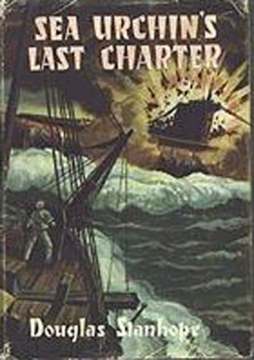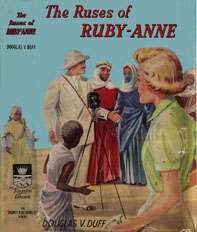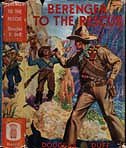| bc |
After reading the information on this website, Elizabeth
O’Reilly, one of Douglas Duff’s two daughters,
sent us some notes for this more detailed biography of
her father. Many thanks to Elizabeth.
 |
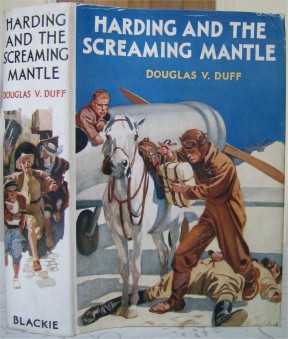 |
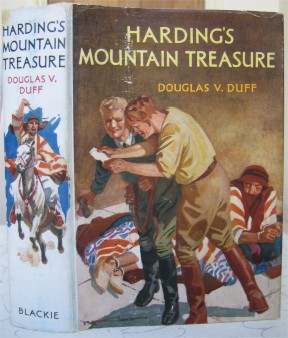 |
| |
bc |
|
 |
Five nice wrappers
from
Steve Rudge |
 |
DOUGLAS V.
DUFF 1901 – 1978
My father, Douglas Duff, was born in
Rosario de Santa Fe in the Argentine in 1901. He was the
eldest son of Arthur Joseph Duff and Florence Valder.
Arthur Duff was the British Consul and Douglas
Duff’s godfather was Roger Casement who later became
notorious by being shot [hung
- see Cormac's message below] for treason in the First World
War.
I believe that it was in 1906 that the
family came home to England and then Douglas and his
younger brother Lewis went to school at the Convent of
the Visitation in Bridport, Dorset.
He entered the famous training ship HMS
Conway in 1914. At the age of 15 in the year 1916 he
joined the Merchant Navy as a cadet for he was determined
to go to war. He was sent to the “ Thracia”
trading between Liverpool and the Mediterranean. On March
27th, 1917 the Thracia was torpedoed in the Bay of
Biscay. At the age of 15 and a half my father was sole
survivor and, for a while, was posted as “killed in
action”. After recovering at the family home in
Ireland he went back to sea. This time he served as a
midshipman and, in an encounter with German U boats, he
had his leg broken.
 |
After recovering Douglas went to
sea again in June 1918 and was again torpedoed.
He was still only 17 years old at the time. Next
he was sent to the Black Sea and was involved in
the rescue of many fugitives from the
Bolshevists. This was a part of his life he never
talked about except to say it was
“indescribable”. |
When shipwrecked from the
Thracia he had made a vow to dedicate his life to God if
he was saved. Thus he entered the noviciate of a teaching
order of monks at Deeping St James in Lincolnshire.
However, after 22 months he left, for he discovered that
he had no vocation for that kind of life. In addition he
found that he had no liking for the discipline and that
he resented the vow of celibacy.
After this he joined the Royal Irish
Constabulary. In the confusion of Irish politics of the
time this was a strange decision. However, it is as well
to remember that sympathies and loyalties in the Irish
situation were often pulled in many directions. Indeed
his Uncle Edward was the High Sheriff of Longford yet he
had helped in hiding IRA members. In Douglas’ own
immediate family his father was angry that he had ever
become a monk and his mother was cross that he had left
the monastery.
He left the RIC when it disbanded in 1922
and joined the Palestine Police. Eventually he made his
way up through the ranks until he was in command of the
police in Jerusalem .He met my mother, Janet Wallace, who
was a nursing sister in Nazareth. He first heard of her
when she was reported as repelling an attack on her
hospital with a broom ! They were married in Scotland in
1932.
After Palestine Douglas expected to get a
post in the Jamaican Police but he had contracted malaria
and was not fit for that sort of tropical duty. Instead
he and my mother set up home in Dorset where my sister
and I were born. He needed to earn a living and so took
up writing and journalism - at one time he was sent to
interview Haile Selassie, the Emperor of Ethiopa.
As the Second World War inevitably
approached he joined the Royal Naval Volunteer
Supplementary Reserve. This later became the RNVR. At
first he took command of “Grey Mist” as part of
the Dover Patrol. Next he was then appointed to the Staff
of Admiral Andrew Cunningham, Commander in Chief of the
Mediterranean Fleet. Under Cunningham he carried out
various duties, serving as Naval Officer in charge at
Derna, and then as officer in command of the Western
Desert Schooner Flotilla running sailing schooners which
were breaking the blockade of Tobruk.
He was next put in command of H.M.S. Stag
(N) whose duties included netting the Suez Canal. In 1943
he was transferred home and appointed Staff Officer
Operations (2) in Falmouth. From there he went to the
Irregular Warfare Department of the Admiralty stationed
at Teignmouth. He was demobilised in November 1945.
His first wife, Janet, died in 1960. He
later married Eveline Rowston who had been a major in the
Q.A.R.N.N.S. (Queen Alexandra’s Royal Naval Nursing
Service.)
He continued writing, broadcasting and
television work until his death in 1978.
He wrote about 100 books in his lifetime
as well as 2 autobiographies ‘ May the Winds
Blow’ and ‘Bailing with a Teaspoon’ which
are both still available on used book sites on the
Internet.
Elizabeth O’Reilly
(nee Duff)
The
Many Lives of Douglas V.
Duff
by Jim Mackenzie
Two of the recent
correspondents to Collecting Books and Magazines have
raised additional information about the life and works of
the author Douglas V. Duff.
The first of these,
Jim Herlihy of Ireland, contacted us about a missing book
from the list that was given on these pages. This was
"Harding and the Mountain Treasure", a copy of
whose dust-jacket can be found here. Thus we can solve
one Harding mystery but must immediately raise another
that our readers may be able to put to rest. The British
Library records that there are 5 books in the Jack
Harding series. However, I have only been able to record
four titles 1. Harding of the Palestine Police. 2.
Harding and the Mountain Treasure 3. Harding and the
Screaming Mantle 4. Jack Harding's Quest. The fifth book
title , whose action must lie somewhere between book 1
and book 4, has so far eluded our searches. Perhaps you
know it and we can add it to the records on these pages.
Jim Herlihy also
uncovered some very interesting facts about Douglas
Duff's early life. The ship that Duff was on during World
War 1 and from which he was the only survivor when it
sank was called the S.S.Thracia. Jim pointed out that you
can now use a search engine to see details of an
underwater dive to the wreck off Britanny. Using the
words "S.S. Thracia " will also lead you to a
remarkable document which is a scan of the original
handwritten record of the French sailors who rescued
"Douglas valder duff" from the sea. Jim also
send on a copy of a photograph of Douglas Duff when he
was in the uniform of the Palestine Police, which we
reproduce here.
John Gaunt's
reminiscences about some childhood time spent in the
company of Douglas Duff reminded me that I had neglected
to trace those books that were written under his various
pseudonyms. Some time ago I had used the British
Library's Catalogue to uncover the most obvious of these.
Here they are with the books he wrote under his
pseudonyms:-
| bc |
Douglas
Stanhope
On Special Service for the Foreign
Legion; 1947 Blackie
Sea Urchin's First Charter; 1947 Blackie
Sea Urchin's Second Charter; 1948 Blackie
Sea Urchin's Third Charter; 1949 Blackie
Sea Urchin's Last Charter; 1951 BlackieLeslie
Savage
When the Sea Boiled; 1948 Hollis and
Carter
Cornish Contraband; 1950 Herbert Jenkins
Peter
Wickloe
The Yellow Ship; 1947 Blackie
To the coasts of Barbary; 1947 Blackie
South Seas of Peril; 1948 Blackie
Bullen of the "Brigadier"; 1949
With the Knights of Malta; 1950 Blackie
Casper Clinton. China Coaster; 1951 Blackie
Mainsail
Fifty Famous Sea Stories 1961
|
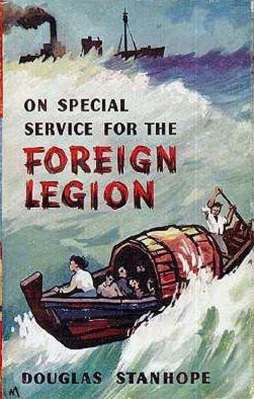 |
Here
are some of the dust-jackets. Some of the books were
already in my collection. I had suspected their
authorship but had never done anything to prove it. The
British Library saved me the job.
You can see that
the years between 1947 and 1951 were extremely busy ones
indeed. A brief count will reveal he wrote 13 books under
these known pseudonyms whilst still turning out 19 under
his own name, including the entire "Bill
Berenger" series and volumes of autobiography.)
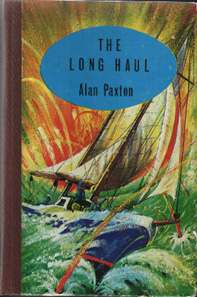 |
Just how
prolific he was during these years is illustrated
by my copy of "The Treasure of
Antarctic" where the dust-jacket proclaims a
list of "Blackie's New Books for Boys".
These include "Trapped in the Jungle",
"The Phantom Submarine" and
"Unfettered Might" by Percy F.
Westerman. Duff's titles under his own name were
"Atomic Valley", "Islands of
Jeopardy" and "The Lost Admiral".
As Peter Wickloe he contributed "The Yellow
Ship" and "To the Coasts of Barbary
and, as Douglas Stanhope, "Sea Urchin's
First Charter" and "On Special Service
for the Foreign Legion". The other authors
mentioned were C.B.Rutley and Douglas Castle.
Both Westerman and Rutley were well known to me.
For a while I toyed with the idea that Douglas
Castle might again be Duff in yet another guise.
The British Library, however, confirms that this
was the pen-name of John Ridley Brown. However,
let us take a look at the author we know so well
as he operates in disguise. |
"Casper
Clinton China Coaster" by PeterWickloe
This story by
Douglas Duff shows the author in typical form. The scene
of the action is the South China Seas. The hero is Casper
Clinton, a man of unknown origin and mixed race. He has
been brought up by Theophilus Clinton on the remote
Balabac Island near north Borneo to work hard and respect
men of all colours and races. At the end of the Second
World War, when he acted as a guide and interpreter to
the Australians and the Americans, he is given the
opportunity to train as a cadet-officer in the
British Mercantile Marine.
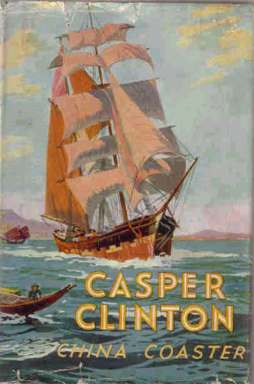 |
When his
first ship, the Trecarrel, runs into a mysterious
barquentine Casper is sent on board to help as
part of the crew who are going to sail the
apparently abandoned vessel into Hong Kong.
However, on board lurks danger in the shape of a
group of deserters from the French Foreign
Legion. After the Trecarrel draws away the
unlucky officer is killed and Clinton and his
Chinese comrades are left at the mercy of
ruthless German renegades. Casper, as the only
person capable of navigating, pilots his way
towards the coast of south China. Out of the
darkness one night the barquentine is attacked by
the crews of pirate junks who capture them and
take them to Swachow. This little enclave is
ruled over by the autocratic Lady Soong Ayesha
who enforces her authority by means of a
constantly busy execution squad. Casper Clinton and his friend Ah
Fong are pressed into the Lady's service and the
young man finds himself running a navigation
school for the strange but brutal Chinese woman.
It takes all of Casper's ingenuity to plot his
escape and keep one step ahead of the people who
want to betray him and win favour with the Lady
Ayesha.
|
The
escape from Swachow is made in the nick of time and
during a remarkable typhoon. The barquentine makes a run
for the south and the book becomes a story of remarkable
endurance by Casper and Ah Fong. Their troubles are not
over when they make a landfall at a remote island, where
they find themselves prepared as sacrifices to a strange
island cult ! Only some remarkable stage trickery by Ah
Fong allows Casper to turn the tables and to allow them
to return to safety and civilization once more.
Sea
Urchin's Second Charter by Douglas Stanhope
The Sea Urchins
were a group of five men who had all been demobilized
from the Royal Navy, but who, not liking the prospect of
settling down ashore, had bought the ship in which they
were serving, the schooner "Sea Urchin". She
was a very special vessel indeed, for she had been built
for the Irregular Warfare Flotilla, and, while looking
like an innocent sailing craft, had concealed aboard her
a mass of special equipment and gear. The premise of each
charter is that the group take on special assignments
that no one else either wants or can manage. During the
war Andrew Barton was the commanding officer with Bill
Sims as his second. Sam Somers had been in charge of the
guns and Tom Fuller was the radio officer. Old Amos, a
sixty five year old Negro, was the cook. However, in
peace time all five are equal partners in their
enterprises. On this charter they accept the money of a
chemical company who want them to find a missing Cornish
man called Penwithers, who is believed to hold the secret
of a remarkable medicine. Unfortunately during his war
service Penwithers disappears on the island of
Madagascar. The political situation on the island is
highly volatile, with the colonial power, the French,
trying to hold down a rebellion by some of the Malagasy
people who live in the remote highland mountains. The
plan is for Bill and Amos to find their way to the rebel
stronghold to follow up the rumours of a "Blind
White Saint". To complete their mission they will
have to pass as Muslims as all Europeans are
automatically executed by the rebels. Bill and Amos
pretend to be arms traders and, after a brief brush with
the French soldiers, are picked up by the people who want
to purchase weapons for the great rebellion.
There is a long
trek to a remote mountain stronghold where they find the
situation complicated by the rivalry between so-called
"Saint" and an old hag who is a traditional
mother-of-the-people witch-doctor who holds enormous
power. A radio message tells Bill and Amos that the Sea
Urchin has been attacked by other scientists who are on
the trail of the marvelous and invaluable medicine. At
this point in the story the two heroes are suddenly cast
into a prison. Thus they need to escape from the prison
fortress, cross a crocodile-infested rivers and then
dodge the rival organisation who have apparently sunk
their schooner and killed their friends.
The fact that there
are several more "charters" to come in the saga
should soon relieve your anxiety about their survival.
After the flood of
stories as Duff moved into the 1950s, the pseudonyms seem
to drop out of usage and perhaps any dispute with Blackie
had been settled by this point. The dust-jacket of
"The Ruses of Ruby-Anne" makes this interesting
contribution to the Duff career story :-
"When the
author of this book formed one of the panel in
Television's 'What's My Line' he startled the chairman by
speaking to one of the challengers in Arabic."
Duff's appearances
on 'What's My Line' are not recorded on the information
you can find on line. However, 'What's My Line'; first
appeared in Britain in 1951 just after the purple patch
of his writing career that we have recorded here. Perhaps
his television appearances are another reason why Duff
gave up the pen-names.
His use of
"Mainsail" as his name as editor for the Burke
series called "Fifty Famous Sea Stories"
allowed him to bring together a collection of classic sea
stories by Melville, Kingston, Henty, Ballantyne and many
more without compromising his work for Blackie and
Nelson. And, so, I thought the story of his many
identities had now come to an end. The British Library
revealed no more known pseudonyms.
Two years ago in a
small second-hand bookshop in the town of Whitby I
learned that I was wrong.
Amongst the few
books that fell into my area of interest was "The
Long Haul" by Alan Paxton. The dedication at the
beginning of this book in the common or garden
"Abbey Rewards" series was to "Stella B.
Buckwalter who, young in heart, has always liked the
young books I have written."
I was sure I had
seen this dedication before but I couldn't be certain. I
bought the book and took it home. I can now confirm that
in "Sea Urchin's Second Charter" the dedication
runs thus, "To Stella Buckwalter in the hope that
this yarn may interest her ever-youthful spirit."
In "Harding's
Mountain Treasure" it reads "To one of my
youngest friends, Stella V. Buckwalter, I dedicate this
tale for boys of all ages, in the hope that she will
enjoy it."
Having read the
book I can now say that Alan Paxton is definitely another
name for Douglas Valder Duff. So many of the old
favourite themes and incidents crop up again. The story
begins in H.M.S Harlech, a Cadet Training School closely
based on H.M.S. Conway. Tim Nuttal and his brother
Alistair are cadets who have a father who served with the
Royal Navy in spite of the fact that they are citizens of
the South American Republic of San Ignacio. Indeed the
entire family are sailing home to San Ignacio in their
ketch Mantlet for the summer holidays. When you learn
that the other member of the family is sister Janet (It
is that name Janet again !) you can feel Duff weaving the
old story one more time.
Encounters with an
underwater volcano (see "The San Matteo" and
various others) and with sea serpents "(see
"Sea Serpent Island") take us down to familiar
territory. The magnificent description of the small
yacht's battle with a hurricane echoes the ones to be
found in "Ocean Haul" or "Casper
Clinton". The clinching moment for me came when the
two boys take their dismasted vessel into safe refuge at
the Isla Jehannum, the former prison island, which we
have already seen visited by Bill Berenger and Adam
MacAdam. Uncovering a missing treasure before the
completion of the voyage is, of course, no more than we
would expect from the versatile heroes of any of Douglas
Duff's stories.
So, the question
is, if Alan Paxton was one unrecorded pseudonym of
Douglas Duff how can we be sure there aren't any more
books and identities to be discovered ? I shall continue
my search.
Jim Mackenzie.
BOOK LIST See comments below re "Harding’s Mountain Treasure" - (later ...)
title corrections, see Steve Rudge comment below.
1. Sword for Hire.
The saga of a modern
free-companion, etc. 1934.
2. Galilee Galloper. [A biography of Edwin G.
Bryant, known as “Abu George,” formerly
superintendent of the prison at Acre.] 1935.
3. Hammer of Allah. 1936.
4. The Horned Crescent. 1936.
5. Palestine Picture. 1936.
6. Harding's Mountain Treasure. 1938
7. Harding and the Screaming Mantle. 1939
8. Jack Harding's Quest. 1939 (7,8 out of order,
keeping series together)
9. The Half-Deck of the ‘Bradstock.' 1938.
10. Palestine Unveiled. 1938.
11. Poor Knight's Saddle. [An account of a visit
to Palestine.] 1938..
12. G. A. Henty's “No Surrender!”
Retold by Douglas V. Duff, etc. 1939.
13. G. A. Henty's Redskin and Cowboy. Retold by
Douglas V. Duff, etc. 1939.
14. Sea Whelps ... Illustrated by L. B. Black.
1939.
15. Desert Peacemaker ... Illustrated by Stephen
Reid. London, 1939.
16. The Desert Knight, etc. London, 1939.
17. The Rough with the Smooth .. [Reminiscences.]
London, 1940. .
18. The Treasure of the Antarctic, etc., 1940.
19. Passage-at-Arms. 1944.
20. A Little Ship, etc. 1945.
21. Looking for Trouble, etc. [A tale for
children.] 1945.
22. Danger Chasers, etc. 1946.
23. Peril on the Amazon ... Illustrated by Leo
Bates. 1946.
24. Islands of Jeopardy
... Illustrated by Ellis
Silas. 1947..
25. The Lost Admiral ... Illustrated by Reginald
Cleaver. 1947. .
26. .Atomic Valley ... Illustrated by Reginald
Cleaver. 1947.
27. Peter Darington –Seaman
Detective 1948
28. Bill Berenger's First Case
... Illustrated by A. Barclay. 1948.
29. Heroes of the Sea ... Illustrated by Wm.
McDowell. 1948.
30. May the Winds Blow! An
autobiography. 1948.
31. Smugglers on the Saltings ... Illustrated by
S. van Abbe 1948. .
32. The Cannons roar., 1949.
33. Sea Wren's Maiden Voyage ... Illustrated by
R. V. Pimlott. 1949.
34. Berenger to the Rescue ... Illustrated by A.
Barclay. 1949.
35. On the World's Roof ... Illustrated by M.
Mackinlay. 1949.
36. East of Suez. 1950..
37. Powder and Shot. 1950.
38. Bill Berenger wins Command
... Illustrated by A. Barclay. 1950.
39. Terror of the Sierras. 1951.
40. Ready, aye Ready” ... Illustrated by A.
Barclay. 1951..
41. Lord of the Desert. 1951
|
42. Berenger's Toughest Case ...
Illustrated by A. Barclay. 1951.
43. The Underwater-Man ... Illustrated by A.
Barclay. 1952.
44. Bailing with a Teaspoon, etc. [An account of
the author's experiences in Palestine.]1953.
45. Miracle Man, etc. 1953.
46. The Ship Slayers, etc. 1953.
47. Foreign Legion Sailor. 1954.
48. The Thickpenny Hoard. 1954.
49. The Story of the Merchant Navy, etc.1954.
50. On Swallowing the Anchor, etc.
[Reminiscences.] 1954.
51. The Ruses of Ruby-Anne. 1955
52. The Singing Cloak. 1955. .
53. Yarns of Blue Water. 1955.
54. Operation Sunpower, etc. 1955.
55. The Sky-Pirates ... Illustrated by Dobson
Broadhead. 1955.
56. The First (Second) Book of the Merchant Navy.
1956.
57. Ocean Haul ... Illustrated by Robert Hodgson.
1957.
58. Sea Pie. [Stories of the Sea. With plates.]
1957.
59. The San Matteo ...
Illustrated by Robert Hodgson., 1957.
60. Sea-Bed Treasure ... Illustrated by Robert
Hodgson. London, 1957.
61. Sea-Serpent Island ... Illustrated by Robert
Hodgson., 1957.
62. Spunyarn. (A book of sea tales.) 1957.
63. Black Ivory ... Illustrated by Robert
Hodgson. 1958
64. The Pale Grey Man ... Illustrated by Robert
Hodgson. 1958
65. The Nuclear Castle Story ... Illustrated by
Robert Hodgson. 1958.
66. Red Sea Blackbirders. [With illustrations.],
1958.
67. Port of Missing Ships ... Illustrated by
Douglas Relf., 1958.
68. Ships of the World. 1958.
69. Yarns of a Shellback. Strange, true tales of
the sea ... Illustrated by Raymond Watkinson.
1959.
70. At Close Grips ... Illustrated by Robert
Hodgson., 1959.
71. Undersea Oiltanker ... Illustrated by Robert
Hodgson.1959.
72. Crusader's Gold ... Illustrated by Robert
Hodgson. 1959
73. Nine Stories of Famous Sieges and Escapes ...
Illustrated by Raymond Watkinson., 1959.
74. Checkmate. Illustrated by Douglas Relf.,
1960..
75. The King's Rescue ... Illustrated by Michael
Godfrey. 1960.
76. More Yarns of a Shellback ... Illustrated by
Raymond Watkinson., 1960..
77. The Stolen Aircraft Carrier ... Illustrated
by Robert Hodgson. 1960
78. Adam Macadam, Naval Cadet ... 1961.
79. The House on the Creek. Illustrated by David
Cobb., 1961.
80. The Man from Outer Space ... Illustrated by
R. George Campbell. 1962
81. Pirates aboard! ... Illustrated by Robert
Hodgson. 1962 |
BACKGROUND
Commander Douglas Valder Duff was a man
who led a life full of adventure and he drew heavily on
his experiences for the 80+ books and the many magazine
stories that he wrote during his career as an author. At
the age of 13 he began his training on the cadet ship HMS
Conway, moored on the River Mersey. A fictionalised
version of some of his experiences there can be found in
his 1939 story “Sea Whelps”. By the time he was
fourteen he was really at sea, serving during the First
World War and, at the age of fifteen, his ship was
torpedoed by the Germans.
The first stirrings of his career as an
author took place during the 1930’s where his focus
was very much on Palestine, describing the people and the
places that he had come to know so well. His work
included both fiction and non-fiction. His first series
hero for children appears to be John (Jack) Harding whose
adventures ranged between England and the deserts of the
Middle East. Later stories also had a South American
flavour with his other popular heroes Bill Berenger and
Adam MacAdam deeply involved with life on that continent.
Although Douglas Duff had a detailed
knowledge of all things nautical, he did not restrict
himself to writing exclusively about the sea. Indeed some
of his novels would be classed as science fiction and one
or two would even fit into the “lost race”
category. Throughout his career as an author he continued
to diversify, providing his readers with volumes of
autobiography and true tales of the sea as well as the
children’s stories for which he was justly famous.#
The San Matteo
Reviewed by Brad Weier.
This book is the fourth in the
series featuring Adam MacAdam. I have not read any of the
other books in the series, or indeed any other by the
author at all. The basic plot of the story is that
MacAdam is to be second in command of "The San
Matteo" (an exact replica of the original 16th
century Spanish galleon) that has just been built by a
master shipbuilder in Penmouth. Its construction was
commissioned by the government of the South American
country of Yraguay. He is to join a hand-picked crew that
must sail the ship from Spain to Yraguay to commemorate
the 400th anniversary of the discovery of the country by
the original crew of the San Matteo. The crew has to
re-enact the voyage without the aid of any modern
inventions.
MacAdam is befriended by a gentleman on
the train journey to Plymouth. The man then offers to
drive him from the station to the ferry, but manages to
drug MacAdam with some suitably modified tea. MacAdam
awakes to find himself in a dungeon. He is soon joined by
two more prisoners who turn out to be members of his
crew. Meanwhile impostors assuming their identities go
aboard ship to prepare to set sail.
Needless to say, MacAdam escapes and
manages to raise an alarm. Word gets back to the ship and
the impostors scarper, including the original skipper,
who was in on the plot. MacAdam is then appointed captain
of the ship and is charged with its safe delivery to
Yraguay. The mystery of why they wanted to hijack the
ship hangs heavily over the story.
Their journey across the sea is a
memorable one. Duff's writing style is fast-paced and
quite detailed and descriptive of all things sailing.
They encounter a huge hurricane, but survive. One of
their officers is injured and as they have no modern
communications equipment, they have to sail at the height
of the storm for shipping lanes to try to intercept any
ship that may have a doctor. The officer is badly hurt
and may not survive. A wonderful passage of writing
describes their decision-making at this point: "Of
course it isn't safe," Dupont snarled. "It'll
be highly dangerous. We'll probably dismast her and roll
her over in the trough when she broaches-to, once we've
ripped the sticks out of her! We may get away with
it--but it'll take every ounce we've got, and all the
seamanship in the world. If we don't risk it, then you'd
better tell the sailmaker to roust out a bolt of canvas
and stand by to sew young Diego up in it, with a couple
of round-shot at his heels to carry him straight down to
Davy Jones's locker."
On finding a ship, they learn that
their country is under threat of takeover by the very
gentleman that befriended MacAdam on the train. The
mystery deepens as to the relevance of their ship to the
coup...
Later, while drifting in the doldrums,
an extraordinary under-sea eruption, best described by
the author as very similar to a nuclear explosion, brings
giant octopuses to the surface. The ship and its crew are
witnesses to a fight to the death between these giant
creatures and a whale. The fight spills over to the ship
and threatens to sink the ship. They are forced to use
the cannon to clear the threat.
On nearing the South American coast,
they are spotted by a giant nuclear-powered flying boat,
formerly of the Yraguayan Navy, now in the hands of the
rebels. This huge craft is described as being able to fly
at incredible speeds and is armed with wing mounted
missiles. The craft lands and comes alongside and it's
crew prepares to board. MacAdam keeps a clear head,
realises that they want to capture the ship, not sink it.
With 400 year-old weapons , he sends this wonderful piece
of modern (1950's science-fiction) technology to the
briny deep!
Finally, still not knowing why their
ship is wanted by the rebels, they make landfall. They
are many miles down the coast from their final
destination. Suddenly they are attacked and besieged by
ancient Inca warriors. After a period of stalemate,
MacAdam goes to meet their chief, only to be clubbed to
the ground and then prepared as a human sacrifice. Things
are looking bad for our hero, when two members of his
crew appear. It turns out that one of them is the long
lost brother of the chief! MacAdam is now a hero and is
afforded all the assistance that the Incas could muster.
He sets sail for the destination port
and arrives exactly on time, to find that all is well in
his country and that the coup had been put down. He is
later told by the authorities that his ship is carrying
four "cobalt" bombs of fifty megatons each, in
the keel of the ship........
So what do I think? Well, it sounds
crazy, but I really liked it. I bought it for $5 on
Saturday and had finished it by Sunday morning.
Incredibly, this book manages to mix ancient-times, lost
tribes, mythical sea-creatures, science-fiction and
nuclear holocaust all into one story. The book zooms
along at a fast pace, with lots of action. It does have a
habit of suddenly ending one scene the immediately taking
up at another point. I think that this is typical of
children's adventure stories of this period. All in all,
a good read, and good value too. I must keep a lookout
for more.... #
Islands of Jeopardy
Reviewed by David Anderson
I only had five minutes in which to browse in my
local bookshop one Saturday, so saw this book on the
shelf (above where Captain W.E. Johns should be but
wasn't), and handed over the requisite five dollars at
the counter. Much cheaper than any of the copies on the
internet, and mine has a nice pictorial dustwrapper too!
The book also has several black and white plates by Ellis
Silas.
This is one of Duff's sailing books, though there is a
small measure of aviation at the very end. It takes place
in the Far East in 1938 though it seems to have been
written well after the War. It is basically a story of
"young English naval cadet against the Japs"
but also has elements of the castaway theme, and
"white man against savage natives".
What is of particular interest is that the young
Englishman is portrayed throughout as impetuous and
foolhardy, and is continually putting his and his
companion's life in danger. His fellow castaway, an
elderly Chinaman called Hu Ming, is shown to be the wise,
sensible one, and he saves both their skins over and over
again. If not for Hu Ming, young Jerry Saunders would
never have made it.
The novel starts off as a straightforward sea tale,
then becomes a Haggardesque "whites v. savages"
adventure in the middle (with a hideous native hag, the
"Enche Lama", that Haggard would have been
proud of), then reverts to a sea/war story in the final
third.
While I think this is probably not Duff's best book,
it is a gripping adventure tale that never lets up from
start to finish. The perils and conflicts are unrelenting
so the excitement scarcely ever ceases in this well told
yarn. Once I had picked it up and read the first few
chapters it was hard to put it down again. I particularly
like the "pulp" streak in Duff's writing style.
I highly recommend this book to those who like the
"Indiana Jones" type of adventure. #
Peter Darington – Seaman Detective
(Thames Publishing Co.)
Reviewed by Jim Mackenzie
The hero of this book, Peter Darington, fulfils
the two roles defined in the above title in a highly
satisfactory way. More than that, Douglas Duff’s
creation in this early collection of 8 short stories is
clearly the forerunner to his later series heroes - Bill
Berenger and Adam MacAdam. From the very start of his
adventures Peter is given all the qualities that any
young reader could still admire today. He is brave,
intelligent, compassionate, understanding and just
vulnerable enough to make his success not too
predictable. The author’s cosmopolitan outlook is
also refreshing and reflects his wide experience of the
world and the people in it. It is not often that you open
a book about a young British hero and read a line which
says,
“Peter knew Arabic and both understood and loved
Arabs…”
Other ethnic groups are also usually treated with a
respect and an even-handedness that allows Duff to create
“goodies” and “baddies” in all the
nations that are visited without there being a suggestion
of a racial slur. It is behavior that matters - not the
colour of a man’s skin.
A tramp steamer with a limited number of passengers on
board is, of course, the ideal setting for a murder
mystery. Two of the stories make use of the confinement
that is achieved by a long voyage where no one can have
committed the crime but the passengers or the crew.
Falling under suspicion himself, Peter remembers the
training given to him by his father, senior officer in
the Palestine Police. He makes a numbered list of all the
clues and weighs up the pros and cons about each suspect.
There may be painstaking method but there is also
satisfying mayhem as each case is normally resolved not
just by deduction but also by fisticuffs. Peter knows how
to disarm a desperate gunman and then knock him out with
“a magnificent uppercut”.
Inevitably Peter Darington’s success as a
detective brings him to the notice of his superiors, with
mixed results. Becoming the “pet” of the
Captain does not make him popular with the Chief Officer
of the Roundstone Minster and it also leads to some
“ragging” from his fellow apprentices. His
youthfulness counts strongly in his favour, however, when
he investigates the case of “The Kidnapped
Heiress”, for who would suspect one of such tender
years to possess such tenacity and courage. Indeed, the
heiress in question is one Janet Summerthly, the daughter
of the millionaire owner of the Red Circle Shipping Line.
Soon Peter is moving in exalted circles and begins to
harbour thoughts he hadn’t expected to trouble him.
“He had never bothered very much about girls, but
she was so different from all the rest.”
As he pursues the criminals in “Terror by
Night” he begins to think about Janet more
seriously. She has already proved her courage by seizing
an unexploded bomb and rushing outside to throw it into a
lake. As he drives along, “Not for the first time,
Peter realised that she was also an extremely pretty
girl.”
Here we can see quite clearly where Douglas Duff
differs from Percy F. Westerman, that other prolific
writer of sea stories whose career overlapped Douglas
Duff’s for at least thirty years. Duff is not afraid
to introduce the female element into his stories and,
though the girls concerned play minor roles, they are
always strong self-reliant types, whose independent
character wins the respect of the hero and forces him to
greater efforts to win theirs in return. Janet Summerthly
is no swooning maiden. She totes a gun and is prepared to
use it. In Westerman stories the lads concerned are lucky
if they have mothers, never mind “lady
friends”.
Mere courage and resourcefulness will not be enough
for Peter to win Janet. Interestingly he has to overcome
his own prejudices and the assumptions of the world he
lives in. He forces himself to stop thinking of her
– “he was an apprentice in her father’s
employ and she was the owner’s only daughter. Things
such as he had begun to imagine didn’t happen. At
least, decent fellows didn’t let them happen, and
that was all there was to it.”
In the next short story in the book, “Dangerous
Mission”, Peter leaves England and Janet behind and
the Roundstone Minster encounters a troubling political
situation in the South American Republic of San Isidore.
This again, like the Palestine and Arab connections
already mentioned, is a constantly recurring theme in
Douglas Duff’s stories. The Republic of Yraguay in
the Adam MacAdam stories, for instance, brings out the
close connection between the United Kingdom and the many
Latin American states where Britons have traded, settled
and intermarried. The resolution of the mystery in this
story concerns a smuggling technique referred to in one
of another collection of Duff short stories entitled
“Heroes of the Sea”. The breadth of the
author’s sea-going experience is never in doubt.
For his success in this story Peter and one of his
shipmates are awarded the M.B.E., but what we really want
to know is whether the author will reward his hero with
the lovely and lively Janet. In “Midnight
Mystery”, depending on your point of view, the signs
are not good. Peter is now so sensitive on the subject of
the millionaire’s daughter that he can be provoked
into instant anger by his fellow apprentices’
callous disregard for his feelings. Their constant jokes
about his future prospects expose a raw nerve that
threatens to make him lose his normal level-headed
approach to each problem that crops up. The mystery in
this story is one of the author’s weakest and the
Duff wraps it all up rather tamely without a dramatic
climax.
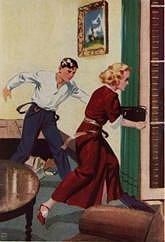 |
However, the fiery Janet and the touchy Peter
cause so many sparks of interest by their
disagreement that the reader is more interested
in the progress in their “impossible”
relationship. And how does it end ? Of course,
you have to read the book yourself to find out. One
of the most attractive features of this oversized
book from “The Headway Library” is the
beautiful display made by the seven coloured
plates by Nat Long. In particular the picture of
Janet racing through the French windows makes you
understand just why Peter finds her both so brave
and so desirable
Douglas Duff wrote many better books later in
his career but this mixture of detective story
and action thriller gives indications of what
would be possible when he moved from the
miniature of the short story and painted with
these colours on a broader canvas. #.
|
Bill Berenger – A
Resourceful Hero
Article by Jim Mackenzie [ jmackenzie48@yahoo.com
]
Bill Berenger's First Case
The pace of the first of Bill Berenger's four
adventures is breath-taking. Eighteen chapters and 287
pages are crammed with excitement and incidents. There is
scarcely ever a pause for reflection and yet the book
succeeds in being a story of detection as well as a yarn
of high adventure.
The hero, Bill Berenger, is the senior cadet on the
Red Diamond Line's merchant -ship, the Chideock Mote,
which, at the beginning of the story, is having its cargo
unloaded in the port of Santa Monica, the capital city of
the republic of San Isidore. Naturally San Isidore is one
of the those South American states so beloved of
storytellers that is on the brink of a revolution.
However, make no mistake about it, Douglas Duff's
creation of this fictional world is not a half-hearted
one. Rapidly though the action moves, the reader is given
the feeling of a real city and of real people, as though
the author were drawing from his own memories of Spanish
American life. In particular his descriptions of Bill's
time amongst the poor people that haunt the Santa Monica
harbour area are vividly convincing. The affection that
comes over for the honest fisherman Pedro Hernandez and
his kind-hearted wife is matched by his disgust at the
treatment he receives from Ignacio, the thief and police
informer. The broken-down shacks, the junk yards, the
rotting wharfs, the shabby mansions, the tumbling
tenements, the Spanish forts, towers and the majestic
cathedral, all form an important part of the backdrop of
Bill's quest for the truth which becomes a fight for
survival.
The plot starts slowly with the arrest of the second
and third officers of the Chideock Mote for the murder of
an Armenian store keeper and the impounding of the ship
until all the evidence is collected. For some as yet
undisclosed reason it becomes clear that the ship itself
has a vital role to play in the coming insurrection. Bill
Berenger makes up his mind that it is his duty to use his
local knowledge, his ability to speak the Spanish dialect
and the training he received from his father in police
methods, in order to save the day. However, first he has
to make a difficult moral choice. Jumping ship or
desertion will mean placing himself outside all the
normal laws and guarantees of British justice. It will
also mean leaving his comrades in the lurch. If he fails,
he faces at the worst death and, at the best, the sure
knowledge that he can never return again to his safe and
comfortable world.
An investigation of the murder scene carried out by
torchlight gives Bill a series of clues which he
investigates with both intelligence and thoroughness. The
very manner of the Armenian's death is striking. He has
been kicked in the windpipe by an expert, a man with
skill in Savatte or foot-boxing. All the clues point
towards a local underworld boss with the nickname Red
Iago. Even when all Bill's evidence is placed in front of
the Minister for the Marine, he refuses to let the two
officers go. It is clear that there is corruption in high
places. The official government and police force are
riddled with informers and traitors. It is almost
impossible to know whom to trust. Even Bill himself,
still in disguise, is recruited to be an assassin,
carrying a briefcase full of explosives to the home of
the one honest man, Miguel de Valdez.
There are many exciting episodes in this story. Best
of all perhaps, is the moment when Bill is attempting to
escape from the Presidio prison amongst the chaos of a
prison riot. He stands perched on the battlements of the
ancient fortress ready to dive into the dark waters
below, not knowing if there are rocks immediately
underneath him. He has the comforting thought that if he
lands safely it will be at the very point where sharks
are fed regularly every day ! Later there is a high-speed
chase in patrol boats in Santa Monica's narrow harbour.
Strangest of all, perhaps, is the fact that the book
reaches page 227 before Douglas Duff decides to introduce
the heroine into the story. Her name is Janet Eve Wallace
and she is a young American whose father owns important
oil concessions in the hinterland of San Isidore. She is
a girl of courage and determination, leaping across
rooftops and down staircases with only a moment's
hesitation. The book ends with the two young people
looking forward to meeting up again.
Berenger to the Rescue
Where the first story in the quartet was set in the
big city of Santa Monica, this adventure is very much one
of the wide open spaces. In fact the sheer scope of the
action is one of its most attractive features. The
detective element is contained in the first few chapters
and, it has to be admitted, this is the weakest part of
the whole book.
Bill Berenger is back in England once more, hoping for
some shore leave so that he can see his newly acquired
girlfriend, Janet Eve Wallace, visiting London with her
millionaire parents. However, an invitation that can't be
turned down takes the unfortunate cadet to Cornwall and
the home of the chairman of the shipping line, Sir Alan
Pascoe. Sir Alan's son, Geoffrey, has been kidnapped and
Bill is asked to help track him down. The kidnappers are
the revolutionary organisation, the Green Camisardos, who
are once again trying to overthrow the democratically
elected government of San Isidore. Sir Geoffrey's ships
are to be used to import over 600 German mercenaries and,
if he does not cooperate, the head of his son will be
sent to him by registered post. Worse than all of this is
the news that Red Iago, the villain of the first book,
has escaped from the island prison of Isola Jehannum.
Once more Bill begins his investigations by
meticulously noting all the details of Geoffrey's
disappearance. His conclusions lead him to believe that
the kidnappers must be staying at the nearby luxury
Headlands Hotel. Immediately he decides to gain
employment there as a "Boots". First of all,
however, he makes a trip to London and this is where the
plot creaks with improbability. As he travels up on the
Cornish Riviera Express by chance he finds himself seated
at the same dining table as three of the enemy kidnappers
! Of course, they don't realise who he is and chat away
in Spanish, little realising that he is word-perfect in
that language. In London there is little time for romance
with Janet Eve, though there are signs of increasing
affection between the hero and heroine.
"Bill took her hand and started to tell her exactly
what he thought of her, and no one has ever looked more
annoyed than did Janet Eve Wallace when her father and
mother came into the room…."
In fact Duff only regains control of the plot when Bill
too is taken prisoner and he and Geoffrey Pascoe face the
perils of an Atlantic Ocean voyage on board a luxury
yacht with a "bucko" mate and a
"bluenose" captain. A hurricane further
complicates matters. The crew comes near mutiny and some
are ruthlessly shot down by the mate as he assumes
command after the death of the captain. As the coastline
of South America draws near, Bill and Geoffrey make their
own plans for escape and a journey in an open boat,
shipwreck, pursuit by hostile Indians, rivers full of
alligators are only some of the perils that have to be
faced as they make their way to safety. Geoffrey is only
eleven and it is clear that Duff has used this lack of
years as a device to draw in the younger readers. The
young lad behaves courageously and also suffers
tremendously.
It is also at the end of the story when you have time
to reflect that you realise that Bill Berenger has
adopted at least four different disguises (including the
habit of a nun !) and killed up to a dozen men. He has
crossed many different terrains – the midnight
streets of Pimlico, the windswept moorlands of Cornwall,
the sands and jungle of the coastal plain, the high
sierras of the Irredentas, the cataracts of a mountain
river in full spate, and that all these landscapes have
been convincingly and interestingly described. Whatever
the disadvantages of using a fictional country, Douglas
Duff gives you a wonderful impression of a mighty
continent whose scale is quite awe-inspiring. And I
haven't even mentioned the underground Inca man-traps !
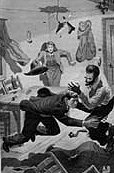
Bill rescuing
Jayee. |
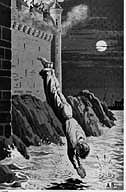
Bill's dive from
the Presidio prison. |
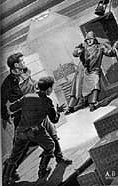
Bill and Geoffrey
cornered
by Mate Larsen in the hold. |
Bill Berenger Wins Command
On board the British cargo vessel, the Messack Mote, a
murder has taken place. A harmless old man has been put
to death. The fact that he was the Chief of Staff of the
San Isidore Armed Forces means that the event is
political dynamite. Already the Red Diamond Company has
developed an unenviable reputation for danger and
disaster in the great republic of San Isidore. Its ships
disappear and accidents happen with inevitable frequency
on their railroads and in their mines. Though promoted to
second mate, Bill Berenger finds that before joining his
new ship in Santa Monica, he must try to solve the crime
that threatens to condemn the British company to further
censure and eventual oblivion. Once again Douglas Duff
starts his book with detection in a confined space and
then opens it up into a rip-roaring adventure.
Apart from the Captain of the Messack Mote the other
officers are skeptical of the efforts of "Young
Sherlock", as they sneeringly call Bill. To their
consternation his systematic method of listing the clues
and the suspects once again pays dividends. No sooner
have he and the captain made the necessary arrests than
Bill decides that the only way for him to overcome the
saboteurs who are ruining the Red Diamond line is to go
under cover disguised as Blomberg, one of the murderers.
And from that point onward it is a search for the
mysterious "El Grande" who has his own plans
for taking over the giant South American republic.
In very quick order Bill becomes a burglar and then a
truck driver. He gradually uncovers the clues in the
grand conspiracy but his only safety lies in everyone
believing that he is dead. This includes Janet Eve, his
girlfriend. Both Bill's friend, Valdez, and Janet Eve' s
parents believe Bill is dead and can't face telling her.
So one day, when a letter arrives out of the blue, the
girl is both dismayed and then rejuvenated. Things have
now progressed so far in their relationship that he calls
her by a special pet name "Jayee".
As the convoy of trucks climbs higher up the roads in
the Cordilleros Ultimos Bill realises that all his
predictions about what was about to happen have gone
astray and that he is getting further and further away
from any help and from the girl that he loves. To get
back down to civilisation once again involves some of the
most exciting writing in the whole series –
sufficient to say it involves an ice-yacht, a frozen
water fall and an encounter with savage forest Indians.
The finale of the story happens at sea in "The Port
of Missing Ships" and, at the end of the adventure
Bill is told he will have to make up his mind whether he
wants to be a detective or a sailor. Jayee has already
made up her mind that he will be neither and Bill is wise
enough not to contradict her.
All the usual ingredients are present but, whilst the
mountain adventures are up to the old standard, the last
section on board ship is an anti-climax.

A dripping Bill
meets his enemies in
Bill Berenger Wins Command |
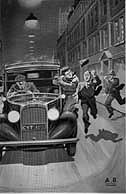
Bill using a Taxi
to get away
from his enemies in Pimlico. |
Berenger's Toughest
Case
Having outwitted Red Iago in two adventures and
disposed of El Grande in the third, Bill takes on the
most dangerous villain of all in the fourth and final
story. This man is called the Fire Seraph and he is
completely insane. Summoned to the head office of the Red
Diamond Line Bill is told by the Chairman that it is his
job to ensure that the Melplash Mote with its cargo of
United Nations atomic weapons gets safely to the Republic
of San Isidore.
"And if she doesn't," Bill put in grimly,
"I suppose I shall be blown sky-high." "If
that happens, you won't need to worry about anything ever
again," Sir Adrian replied, his smile becoming very
friendly.
And the usual roller-coaster of events is set in motion.
Kidnappings on the streets of London, time-bombs in the
ship's hold, bombings by a flying boat, fire in an
explosives store, and attacks by sharks. Bill comes
through them all as usual. The Fire-Seraph's plans for a
Latin American super-state come to nothing and Bill finds
himself home at last on the estancia owned by his father
with all his loved ones, including Jayee, around him. The
adventure is not yet over, for the Fire Seraph has eluded
capture and wishes to take a dreadful revenge on the man
who thwarted all his plans. A horde of over six hundred
wild men from the mountains surrounds the remote ranch
and then begins to move in closer. It seems that to save
everything precious in his world Bill has to sacrifice
himself to certain death. And there let us leave him,
saying farewell to Jayee.
"I still think you're wrong, Bill," she said
quietly, "but I understand what is driving you, and
oh, my dear, if you are killed by those devils out there,
I shan't care how soon it is before they break in and
make an end of me."
An Overview of the Series
In the opinion of this reviewer the first two stories
in the series are by far the best. The contrast between
the city adventures of the first case and the great
outdoors of the second demonstrates Duff's versatility. I
can recommend these without reservation. The third story
has its moments, including the splendid ice-yacht episode
and the last shows signs of tiredness and, without doubt,
is the weakest. It's time that Bill settled down with
Jayee and raised a family in San Isidore, a country that
should at last be free from the perpetual danger of armed
revolution.
It should be noted that quite a few of the details of
these Berenger stories had already been given an airing
in "Peter Darington – Seaman Detective".
This includes calling the heroine Janet ! On another
lighter note Duff obviously enjoyed an in-joke for one of
the apprentices in "Berenger Wins Command" was
called Dick Valder. Valder is, of course, Douglas V.
Duff's unusual second name. #
Contemporary reviews
May the Winds Blow (Hollis
& Carter, 16/-) from the Illustrated London News,
p124, Jan. 22, 1949.
"A naval figure, of almost legendary character,
tells his own story in May the Winds Blow ...He
has seemingly packed more action and excitement into his
life than the average individual can conceive, and he
writes of it all with a gusto that is infectious. ...
There is a rich Elizabethan flavour about
Lieut.-Commander Duff of the RNVR. Here is a full book of
a full life." W R Calvert
Reader Comments
Date: 11/08/06
I read with interest your page on Douglas V Duff and
the biographical contribution from his daughter
Elizabeth. I knew Duff well and as a boy many years ago,
when the Duff family lived in an old vicarage in my home
village in Lincolnshire, I spent hours talking with him
(or mostly listening to him). I well remember Elizabeth
and her sister from the same time.
I write to mention that he once explained to me that he
was, or had been, in dispute over royalties with his
publisher, Blackie, and to circumvent the problem had
produced some books for boys under a nom de plume. I do
not see a reference to this on your page. As far as I can
recall the pen-name was Douglas Stanhope and Douglas gave
me one of his books written under that name, which
unfortunately I have misplaced. Its title was The Sea
Urchin's First Charter and it was an adventure story set
in the South Pacific. I think he wrote a sequel
(unsurprisingly, The Sea Urchin's Second Charter).
He was a fascinating man, in some ways a bit of an
Ancient Mariner, full of wonderful yarns and a mine of
information on the Middle East in particular. He kept me
enthralled with stories - of his encounters in Palestine
with the then Lieutenant-colonel Bernard Montgomery, who
viewed him with a heartily reciprocated dislike; of his
attempt as a keen youngster in the RIC to arrest Michael
Collins in the main thoroughfare in Dublin (who told him
not to be so stupid because he was surrounded by
bodyguards who would kill him before he'd taken a step);
of his night-time exploits at Tobruk in a decrepit
motor-driven blockade-runner he called Eskimo Nell, and
many others.
I was very fond of him and he was very kind to me.
John Gaunt
Cascais, Portugal
Thanks for your
memories and comments, John.
Date: 30/01/07
I note on the website that there
appears to be one book missing written by D.V. Duff,
namely, “Harding’s Mountain Treasure”,
published by Blackie & Son, London & Glasgow.
This book was part of the Jack Harding Adventure series.
I am not aware what year it was published but would be
interested to find out.
Regards,
Jim Herlihy
P.S. My interest in D.V. Duff is that I have written a
history of the Royal Irish Constabulary, of which he was
a member.
Thanks, Jim
later.. See Steve Rudge's letter below...
From: Graham Sheppard
Date: 28/05/10
I was given "Smugglers on the Saltings" as a
Christmas present in the early fifties, and probably let
a couple of years slip by before I read it. Not only was
it a great yarn, but as a young lad I learnt so much from
it. Douglas Duff went out of his way to explain things,
terms, logical reasoning etc. I read the socks off that
book !
I joined the Army, went off to the Far East, and by the
time I got back, that book had been "passed on"
!
But recently whilst driving through Blythburgh on the
Suffolk A12 I looked across the saltings and that title
flashed across my mind - Smugglers on the Saltings. Must
find a copy, I thought. I soon located a copy through Abe
books and duly purchased it on line, but it got lost in
the post ! So back to Abe books and a second copy was
found, complete with original dust jacket, depicting Jane
and Jim escaping from captivity in a mill by climbing
down the sails from the top. Douglas describes in
detailed suspense, the difficulties encountered in
negotiating the brass cap of the hub; one trouser belt to
the rescue !
The second copy turned up, but now so has the first ! I
lost no time in reading it and it is still a fine yarn,
fifty five years on. Of course, the technology in it is
very dated but that is very appealing, but for a
children's book it is quite mature reading.
It has been an immense pleasure to sneak back to my
boyhood through this book. Now I am going to invite one
of my grand-daughters to see what she makes of it.
Thank you Douglas, what an interesting life you had.
Graham Sheppard
Colchester (there are saltings just down the road !)
Thanks for your comments,
Graham.
From: Steve Rudge
Date: 14/7/2011
To aid your bibliography and answer the reader's question on Harding's
Treasure - it should read:
Harding's Mountain Treasure (1938)
Harding and the Screaming Mantle (1939)
Jack Harding's Quest (1939)
The Firsts are all dated to the rear of the title page.
Regards,
Steve.
Thanks, Steve; I've made corrections and
amendments above. Thanks also for the nice cover photos.
From: Cormac
Date: 3/1/2012
Dear Sir,
I'm a history teacher based in Ireland. I'm interested in establishing
contact with Douglas V. Duff's daughter Elizabeth O'Reilly. He was a
novelist and has a profile on your page. On the information on Duff you
say that Roger Casement was shot. He wasn't shot he was hung. The other
1916 Rebellion leaders were shot as Dublin was under martial law at the
time. Casement was tried in England and hung for treason.
I'd greatly appreciate any help you might be able to give me.
Cormac
I've amended the text above but no longer
have Elizabeth's email address. Thanks for your message.
Back to
Collecting Books & Magazines index.
|
bc |










